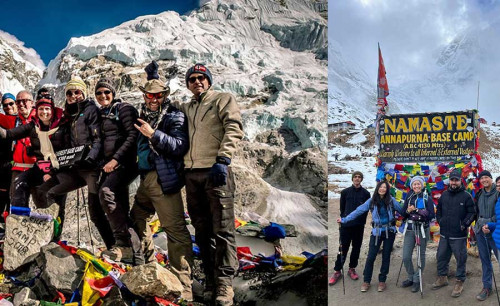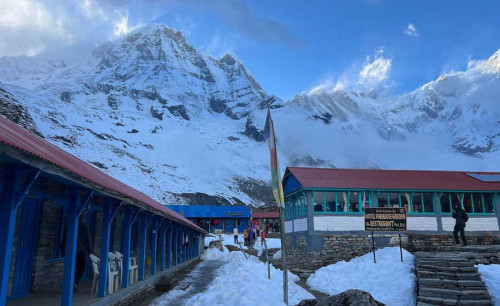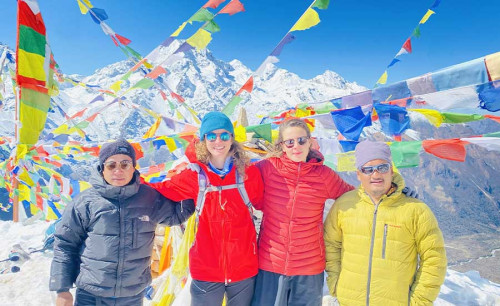Discover Tengboche Monastery: Spiritual Heart of the Everest Region
Published On : 2nd Jun, 2024 By Himalayan Dream Team

Establishment of Tengboche Monastery
Tengboche Monastery, a renowned spiritual center in the Everest region, was established in 1916 by Lama Gulu. Located at an impressive altitude of 3,867 meters (12,687 feet), it offers breathtaking panoramic views of the Himalayas, including the majestic Mount Everest. The primary purpose of its establishment was to create a spiritual haven for Buddhist monks and practitioners. Over the years, despite facing several natural disasters such as the 1934 earthquake and the devastating fire in 1989, Tengboche Monastery has been rebuilt and restored, preserving its spiritual essence and continuing to serve its community.
The architecture of Tengboche Monastery is a stunning fusion of traditional Tibetan and Nepalese styles. The monastery features intricately carved wooden beams, vibrant murals depicting Buddhist deities, and a significant statue of Guru Rinpoche, also known as Padmasambhava. These architectural elements not only add to the aesthetic beauty of the monastery but also hold deep spiritual significance. The serene environment, coupled with the harmonious chants of the monks, creates an atmosphere of peace and tranquility, making Tengboche Monastery a true sanctuary for the soul.
One of the most striking aspects of Tengboche Monastery is its resilience and ability to rise from adversity. After being damaged by the 1934 earthquake, the monastery was meticulously rebuilt to retain its original charm and spiritual ambiance. Similarly, following the 1989 fire, extensive restoration efforts were undertaken to ensure that Tengboche Monastery remained a beacon of Buddhist practice and cultural heritage in the Everest region. These efforts have not only preserved the physical structure but also strengthened the community's dedication to maintaining their spiritual traditions.
The location of Tengboche Monastery adds to its allure, attracting not only devout Buddhists but also trekkers and tourists from around the world. The monastery is strategically positioned on the Everest Base Camp trek, making it a popular stop for those seeking spiritual solace and breathtaking views. The high altitude and stunning scenery provide a unique setting for meditation and reflection, enhancing the spiritual experience for visitors and residents alike.
In essence, Tengboche Monastery is more than just a religious site; it is a symbol of spiritual resilience, cultural heritage, and architectural brilliance. Its establishment by Lama Gulu in 1916 marked the beginning of a spiritual journey that continues to inspire and attract people from all walks of life. The monastery's enduring presence, despite the challenges posed by natural disasters, highlights its importance as a spiritual and cultural landmark in the Everest region.
Community and People of Tengboche Monastery
The community surrounding Tengboche Monastery is predominantly Sherpa, an ethnic group renowned for their resilience, hospitality, and deep-rooted Buddhist faith. This close-knit community has a symbiotic relationship with the monastery, which serves as both a spiritual and cultural hub. Many Sherpa families send their children to Tengboche for education and monastic training, ensuring the continuity of their religious and cultural heritage. This intergenerational connection underscores the monastery's pivotal role in preserving Sherpa traditions.
Active participation by the villagers in the monastery's upkeep and activities is a testament to their dedication and communal spirit. They often volunteer their time and resources to support the monastery, reflecting a strong sense of mutual support and cooperation. This collaboration not only helps in maintaining the monastery's infrastructure but also strengthens the community bonds, making Tengboche a vibrant center of social and spiritual life in the Everest region.
The rich oral traditions, folktales, and legends of the Sherpa people further enrich the cultural landscape of the region. These stories, passed down through generations, are an integral part of the community's identity and heritage. The monastery often serves as a venue for these cultural expressions, making it a repository of Sherpa history and tradition. The storytelling sessions and cultural gatherings at Tengboche provide a unique insight into the Sherpa way of life, attracting both locals and visitors.
Tengboche Monastery's role extends beyond spiritual guidance; it is a central institution in the social fabric of the Sherpa community. The monastery organizes various events, festivals, and religious ceremonies that bring the community together, fostering a sense of unity and shared purpose. These events are not only spiritually enriching but also serve as opportunities for social interaction and communal celebration, reinforcing the monastery's role as a cornerstone of Sherpa society.
In summary, the Sherpa community's relationship with Tengboche Monastery is characterized by mutual support, cultural preservation, and spiritual dedication. The monastery stands as a beacon of Sherpa culture, fostering education, preserving traditions, and providing a central gathering place for social and religious activities. This enduring relationship highlights the importance of Tengboche Monastery in the lives of the Sherpa people and its significance as a cultural and spiritual landmark in the Everest region.
Cultural Significance and Festivals of Tengboche Monastery
Tengboche Monastery is a vital part of Sherpa culture and Buddhist tradition in the Everest region. It serves as a central hub for religious and cultural activities, playing a crucial role in preserving and promoting the rich heritage of the Sherpa people. The monastery's influence extends beyond the spiritual realm, deeply embedding itself in the social and cultural fabric of the community.
One of the most famous festivals celebrated at Tengboche Monastery is the annual Mani Rimdu festival, held in October or November. This grand celebration is a highlight of the monastery's cultural calendar and attracts a significant number of pilgrims, trekkers, and tourists from around the globe. Mani Rimdu involves elaborate masked dances, prayers, and rituals performed by the monks, symbolizing the triumph of Buddhism over the ancient Bon religion. The vibrant and colorful festivities offer a unique glimpse into the spiritual and cultural life of the Sherpa people.
The three-day Mani Rimdu festival draws pilgrims, trekkers, and tourists from around the world. This influx of visitors not only underscores the festival's significance but also boosts the local economy. During the festival, the monastery courtyard transforms into a stage for the monks' performances, which are both spiritually meaningful and visually captivating. The dances, accompanied by traditional music and chants, depict various episodes from the life of Guru Rinpoche (Padmasambhava) and the teachings of Buddhism.
Mani Rimdu provides a unique insight into the region's rich cultural heritage. The festival's rituals and performances reflect the deep-rooted Buddhist traditions and the cultural identity of the Sherpa people. Visitors have the opportunity to witness and participate in these ancient practices, gaining a deeper appreciation of the Sherpa culture and Buddhist spirituality. The festival also serves as a communal event, bringing together locals and visitors in a shared celebration of faith and heritage.
In summary, Tengboche Monastery's cultural significance is highlighted by its vibrant festivals, especially the Mani Rimdu festival. These celebrations play a crucial role in preserving and promoting Sherpa culture and Buddhist traditions. The monastery's ability to attract visitors from around the world for these events underscores its importance as a cultural and spiritual landmark in the Everest region. Through its festivals, Tengboche Monastery continues to be a beacon of cultural heritage and religious devotion.
During Mani Rimdu, the monastery courtyard becomes a stage for the monks' performances, which are both spiritually significant and visually stunning. The dances, accompanied by traditional music and chants, depict various episodes from the life of Padmasambhava (Guru Rinpoche) and Buddhist teachings. The festival concludes with the distribution of blessed pills and the dismantling of the sand mandala, symbolizing life's impermanence. This cultural heritage preserves the Sherpa people's spiritual traditions and strengthens communal bonds.
Religious Practices and Teachings at Tengboche Monastery
Tengboche Monastery is a center for Vajrayana Buddhism, playing a crucial role in the religious life of the Everest region. The monastery adheres to the Nyingma tradition, one of Tibetan Buddhism's oldest schools, which emphasizes the teachings of Guru Rinpoche and the practice of Dzogchen (Great Perfection). This tradition forms the foundation of the monastery's religious practices and teachings, guiding both monks and lay practitioners on their spiritual paths.
Daily rituals at Tengboche Monastery include morning and evening prayers, meditation sessions, and the recitation of sacred texts. These rituals are integral to the monastic routine and provide a structured framework for spiritual practice. The monks also engage in tantric practices and rituals aimed at achieving spiritual development and enlightenment. These practices are deeply rooted in the Vajrayana tradition, which focuses on the transformation of the mind through meditation and the visualization of deities.
Visitors to Tengboche Monastery can participate in these spiritual practices, offering a rare glimpse into the life of the monks. The monastery welcomes those who seek to deepen their understanding of Buddhism and experience its practices firsthand. Participation in these rituals allows visitors to connect with the spiritual essence of the monastery and gain insights into the profound teachings of Vajrayana Buddhism.
The monastery's library houses an extensive collection of Buddhist scriptures, texts, and commentaries, serving as valuable resources for both monks and lay practitioners. This rich repository of knowledge supports the educational and spiritual needs of the monastic community. The texts and scriptures offer a comprehensive understanding of Buddhist philosophy, ethics, and practices, providing a solid foundation for spiritual growth.
The teachings at Tengboche Monastery emphasize compassion, mindfulness, and wisdom, guiding individuals on their spiritual journey. These core values are central to Buddhist practice and are reflected in the daily lives of the monks. By embodying these principles, the monastery fosters an environment of peace, harmony, and spiritual enrichment. The teachings inspire both residents and visitors to cultivate a compassionate and mindful approach to life, contributing to their overall well-being and spiritual enlightenment.
Importance and Significance of Tengboche Monastery
Tengboche Monastery is crucial not only for the local Sherpa community but also for the broader Buddhist world. As a spiritual center, it serves as a vital hub for religious activities and cultural preservation. The monastery's influence extends beyond the immediate region, attracting pilgrims, spiritual seekers, and Buddhist practitioners from around the globe. This wide-reaching significance underscores its role in promoting Buddhist teachings and fostering a deeper understanding of the religion.
One of the key aspects of Tengboche Monastery's importance is its strategic location on the Mount Everest pilgrimage route. Situated on the Everest Base Camp trek, it becomes a natural stop for trekkers and climbers, offering them a place for rest and reflection. The influx of visitors not only highlights the monastery's spiritual appeal but also supports the local economy, making it a pivotal part of the tourism infrastructure in the Everest region.
The monastery attracts thousands of visitors annually, including trekkers, climbers, and spiritual seekers. These visitors are drawn not only by the monastery's religious significance but also by its breathtaking views and serene environment. Tengboche provides an ideal setting for meditation and spiritual practices, with the majestic Himalayas as a backdrop. This unique combination of natural beauty and spiritual ambiance makes it a compelling destination for those seeking inner peace and enlightenment.
The monastery's role in environmental conservation and sustainable tourism is another significant aspect of its importance. The monks and local community engage in various initiatives to protect the fragile Himalayan ecosystem. These efforts include reforestation projects and waste management programs, reflecting the Buddhist principle of living in harmony with nature. By promoting sustainable practices, Tengboche Monastery helps preserve the region's natural beauty for future generations.
In essence, Tengboche Monastery stands as a beacon of spiritual resilience, cultural heritage, and environmental stewardship. Its rich history, profound teachings, and vibrant community make it a cornerstone of Buddhist practice in the Himalayas. The monastery's enduring presence and ongoing contributions to both spiritual and ecological well-being highlight its profound significance in the Everest region and beyond.
Beyond its religious and cultural aspects, Tengboche Monastery plays a vital role in environmental conservation and sustainable tourism. The monks and local community are involved in initiatives to protect the fragile Himalayan ecosystem, including reforestation projects and waste management programs. These efforts reflect the Buddhist principle of living in harmony with nature and underscore the monastery's commitment to preserving the Everest region's natural beauty for future generations.
Tengboche Monastery is a testament to Buddhism's enduring spirit in the Himalayas, offering a sanctuary of peace, a center of cultural heritage, and a beacon of environmental stewardship. Its rich history, vibrant festivals, profound teachings, and close-knit community make it a destination of immense significance and a source of inspiration for all who visit.
Ultimate Everest Base Camp Trek Itinerary: A 16-Day Adventure
Day 1: Arrival in Kathmandu
Arrive in Kathmandu, the vibrant capital of Nepal. After clearing customs, you'll be greeted at the airport and transferred to your hotel. Take the rest of the day to relax and explore the local area.
Day 2: Sightseeing in Kathmandu and Trekking Preparation
Spend the day exploring the rich cultural heritage of Kathmandu. Visit UNESCO World Heritage Sites such as Swayambhunath (Monkey Temple), Pashupatinath Temple, Boudhanath Stupa, and Durbar Square. In the evening, prepare for your trek with a briefing from your guide.
Day 3: Fly to Lukla and Trek to Phakding
Take an early morning flight to Lukla (2,860 meters), the gateway to the Everest region. After a short, scenic flight, begin your trek to Phakding (2,610 meters). Enjoy the beautiful landscapes as you hike through picturesque Sherpa villages.
Day 4: Phakding to Namche Bazaar
Trek from Phakding to Namche Bazaar (3,440 meters), the bustling hub of the Khumbu region. The trail passes through lush pine forests, crossing the Dudh Koshi River several times via suspension bridges adorned with prayer flags.
Day 5: Acclimatization Day in Namche Bazaar
Spend the day acclimatizing in Namche Bazaar. Explore the local markets, visit the Sherpa Museum, and take a short hike to the Everest View Hotel for stunning panoramic views of Everest and Ama Dablam.
Day 6: Namche Bazaar to Tengboche
Trek from Namche Bazaar to Tengboche (3,860 meters), home to the famous Tengboche Monastery. The trail offers breathtaking views of Everest, Lhotse, and Ama Dablam. Visit the monastery and soak in the serene spiritual atmosphere.
Day 7: Tengboche to Dingboche
Continue your trek to Dingboche (4,410 meters), passing through rhododendron forests and crossing the Imja Khola. Dingboche is a charming village with impressive views of Ama Dablam and the surrounding peaks.
Day 8: Acclimatization in Dingboche
Take another acclimatization day in Dingboche. Hike to Nagarjun Hill or Chukhung Valley for acclimatization and incredible views of Makalu, Lhotse, and other peaks. Rest and prepare for the higher altitudes ahead.
Day 9: Dingboche to Lobuche
Trek from Dingboche to Lobuche (4,940 meters), passing through the memorial area of Thukla Pass, dedicated to climbers who have lost their lives on Everest. The trail offers spectacular views of the surrounding glaciers and peaks.
Day 10: Lobuche to Gorak Shep and Visit Everest Base Camp
Continue your trek to Gorak Shep (5,170 meters), the last stop before Everest Base Camp. After a short rest, hike to Everest Base Camp (5,364 meters), where you'll have the opportunity to stand at the foot of the world's highest mountain.
Day 11: Gorak Shep to Kala Patthar and to Pheriche
Early in the morning, hike to Kala Patthar (5,545 meters) for sunrise views of Everest and the surrounding peaks. Descend to Gorak Shep for breakfast, then trek to Pheriche (4,240 meters).
Day 12: Pheriche to Namche Bazaar
Trek from Pheriche back to Namche Bazaar. Enjoy the descent as you pass through familiar villages and landscapes, reflecting on the incredible journey you've undertaken.
Day 13: Namche Bazaar to Lukla
Continue your descent from Namche Bazaar to Lukla, enjoying your last day of trekking in the beautiful Khumbu region. Celebrate your successful trek with your team upon arrival in Lukla.
Day 14: Lukla to Kathmandu
Fly from Lukla back to Kathmandu. Upon arrival, transfer to your hotel and enjoy the rest of the day at leisure. Reflect on your journey and explore more of Kathmandu.
Day 15: Free Day in Kathmandu
Enjoy a free day in Kathmandu. Use this time to relax, shop for souvenirs, or explore more of the city's cultural sites. Optional tours and activities can be arranged.
Day 16: Transfer to International Airport
Transfer to the international airport for your departure flight. Say farewell to Nepal with unforgettable memories of your Everest Base Camp trek.
Cost Details
The total cost for this 16-day Everest Base Camp trek itinerary is from $1,700. This includes airport transfers, accommodation, guided sightseeing in Kathmandu, flights to and from Lukla, all trekking permits, experienced guides and porters, and meals during the trek. Additional costs may include travel insurance, personal expenses, and tips for the trekking staff.
Embark on this incredible adventure and experience the awe-inspiring beauty of the Everest region while immersing yourself in the rich culture and heritage of Nepal.
Recent Posts
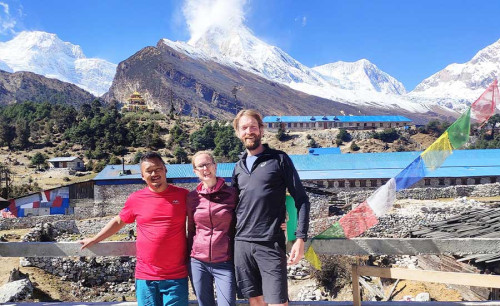
24th Nov, 2025

21st Nov, 2025
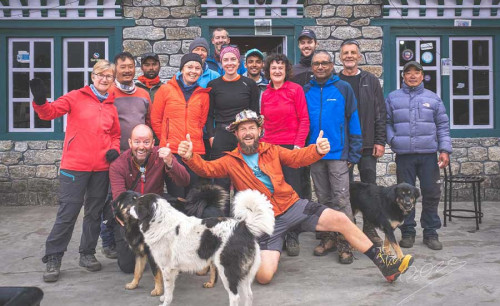
10th Nov, 2025
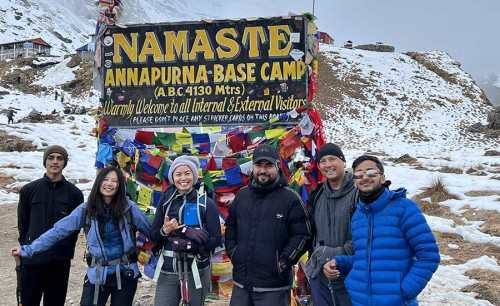
9th Nov, 2025

25th Oct, 2025

22nd Oct, 2025

17th Oct, 2025

17th Oct, 2025

13th Oct, 2025

12th Oct, 2025


